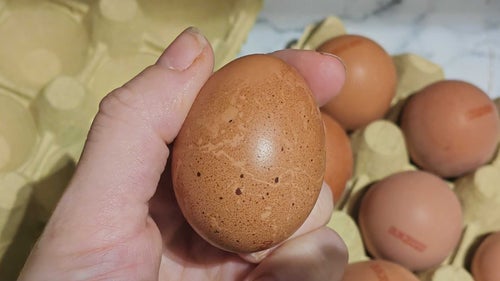

Remember how we all acted around wonky veg when we found out how much perfectly good produce was being thrown away?
Well, that was for something that’s just as good as the regular kinds; pullet eggs, I would argue, are better than plain ones for certain tasks.
Never heard of them before? I was in the same boat until a couple of days ago, when I came across them in a market.
They were smaller and a bit cheaper than the usual kind; they’re the first eggs pullets (hens under a year old) lay.
Supermarkets don’t usually like to take them because they’re smaller than the eggs hens lay across the rest of their lifetime.
“While pullet eggs can make up 10% of an egg farmer’s overall stock, most of them are thrown away,” The Guardian wrote in 2019.
Do they taste different to “regular” eggs?
Yes. They’ve got a creamier white and a bigger yolk; pastry chefs love them, culinary site Food Republic says, because the trick of adding one extra yolk to your mix for added richness becomes unnecessary.
I proved this to myself yesterday by making custard with whole pullet eggs instead of just yolks (I can never be bothered to use up the egg whites); it was even richer than usual.
Their brighter-yellow yolks add a distinctive hue to glazes and custard, too.
In 2015, Jamie Oliver praised the tasty eggs in Farmer’s Weekly, saying “The great British public are missing out on a premium, seasonal product.”
The Mac’s Farm Sussex writes on their site that “pullet eggs are eggs at their very best,” adding, “the yolks are big, brightly coloured and have a unique richness to them.”
“They also hold their shape amazingly well in the pan, sitting like little mountains,” the site adds (it’s true ― I’ve never seen more cartoonishly perfect fried eggs).
They’re seasonal as they only occur just before hens’ laying season, but that “season” depends on the farmer and their individual setup.
Huh. Any issues with them?
The biggest problem, especially when baking, is working out how to measure them.
Not only are the eggs smaller than regular kinds, but those small sizes can vary, and even once you’ve accounted for overall volume, the ratio of yolk to white is different.
So they won’t be great for, say, a meringue; but if you crave the richness of yolks, “egg math” ends up being pretty intuitive.
Two pullet eggs will make up about one extra-large egg, while you might want to add three of them to constitute two medium-sized ones.
For my custard recipe (and various glazes and curds since), I’ve simply put whole pullet eggs in in place of a yolk and haven’t seen any downsides.
It can be hard to get your hands on pullet eggs in-store, though Waitrose started selling packs of four for £1.99 in 2019.
But checking your farmer’s market and looking online will yield great results ― and even better bakes.